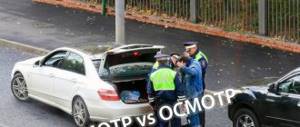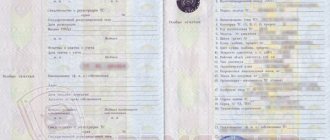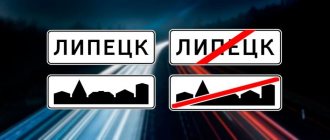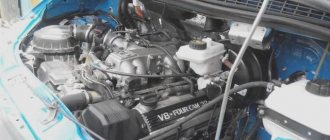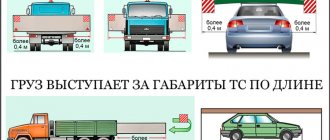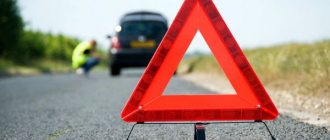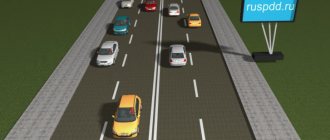Good afternoon, dear reader.
In the previous article in the series “Rules for towing a car,” types of towing and their main features were discussed. Let me remind you that we were talking about towing with a flexible hitch, with a rigid hitch, and by partial loading.
This article will discuss the rules for towing vehicles , which are common to all types of towing, as well as possible penalties for violating these rules:
- Towing and towed vehicles.
- Lights when towing.
- Maximum speed when towing.
- Towing on a motorway.
- Experience of drivers in towing.
- Conditions under which towing is prohibited.
- Fine for improper towing.
- Accident while towing.
Towing and towed vehicles
To begin with, let’s look at the differences between the concepts of “towing vehicle” and “towed vehicle,” which quite often cause difficulties for drivers who are picking up the rules of the road for the first time.
A towing vehicle is a vehicle that performs towing. It sits at the front and pulls the other vehicle using a flexible or rigid hitch. In the picture above, the towing vehicle is the blue car.
The towed vehicle is the vehicle that is behind, i.e. a car being towed. In the picture, the vehicle being towed is a white car.
Towing a vehicle with a rigid hitch
The connecting element here is a special cylindrical metal rod or a towing structure of two rods that are connected at an angle (“triangle”). This type of towing is not used to move passenger cars, since its design does not provide for this.
Rules for towing a car with a rigid hitch:
- The length of the towing rod should be about 4 meters and not exceed this figure;
- It is necessary for the driver to be behind the wheel while moving in order to adhere to the correct trajectory;
- Towing with faulty steering is prohibited.
Lights when towing
Traffic laws require that the towed (rear) vehicle be clearly visible on the road:
- Hazard warning lights (hazard warning lights) or emergency stop sign. A warning triangle may only be used if the hazard warning lights are faulty. In this case, the sign itself is attached to the rear of the towed vehicle.
- Side lights . When driving at night or in tunnels.
Also, don't forget that in 2021, all moving vehicles must have daytime running lights, low beam headlights, or fog lights on.
That is, both the towing and the towed vehicles must have one of the listed types of lighting devices turned on.
Towing a vehicle with a flexible hitch
In this towing, the connecting link is a nylon or steel cable.
Advertisement
Rules for towing a car with a flexible hitch:
- The length of the cable should be no more than 4 - 6 meters;
- The tow rope should not dangle along the road or touch it;
- To visually mark the cable, 2 flags measuring 215 × 200 mm are used. They are depicted as white and red stripes diagonally 50 mm wide;
- The driver must be behind the wheel in order to keep the trajectory set by the distance;
- If the towed vehicle has broken steering and/or brake systems, this type of towing is prohibited;
- Do not tow on slippery roads.
Drivers' towing experience
In 2021, the driver of a towing vehicle can only be a person who has held a driver's license for 2 years or more . That is, a novice driver cannot control a towing car. You can find out more about this change from April 4, 2021 in a separate article.
No such requirements apply to drivers of towed vehicles.
Conditions under which towing vehicles is prohibited
1. A “trailer prohibited” sign prohibits the towing of motor vehicles:
2. Towing by motorcycles without a side trailer, mopeds and bicycles, as well as towing of such vehicles is prohibited. Those. motorcycles, bicycles and mopeds cannot act as either a towing or a towed vehicle.
3. It is prohibited to tow several vehicles at the same time.
Note. However, the rules do not prohibit the simultaneous towing of several trailers.
With a guy! What you need to know about proper towing so that it doesn’t turn out like in the funny videos
It turns out that even fairly experienced drivers do not always know how to drive a flexible hitch. Neither as a “tractor”, nor as a “trailer”. This is understandable: they are not specifically taught this, and the need for towing occurs infrequently. Let's try to fill this gap and figure out how to carry a car on a cable correctly, so as to save your nerves and money and not end up on Youtube.
From a legal point of view
To begin with, let’s remember what traffic regulations require for towing with a flexible hitch - Chapter 26 of the Rules is devoted to this topic:
— towing with a flexible hitch should only be carried out if there is a driver behind the wheel of the towed vehicle;
— the towing vehicle must have low-beam headlights on, the towed vehicle must have hazard warning lights on, and if they do not work, an emergency stop sign must be attached to the rear;
— the distance between the machines should be within 4-6 m, the cable should be marked with warning flags or shields (at least two) measuring 20 x 20 cm with red and white alternating stripes applied diagonally to them;
— the speed when towing should be no more than 50 km/h;
— in icy conditions, towing with a flexible hitch is prohibited;
- you cannot “pull” two or more cars at the same time; towing with road trains, motorcycles without a side trailer, mopeds and the actual towing of such motorcycles and mopeds is prohibited.
— the towed vehicle must have a working brake system and proper steering.
We especially note clause 193.5 of the traffic rules, which prohibits the towing of motor vehicles on a flexible hitch, “if the operation of their working brake and (or) steering systems is associated with the operation of the engine, which is stopped.” The power brakes and steering of almost any car (with a few exceptions) function only when the engine is running - so, according to traffic regulations, towing a car with the engine turned off is prohibited?
Technical aspect
In addition to traffic regulations, what else should a driver take into account? A car with an automatic transmission can be towed, but preferably over a short distance, at speeds up to 50 km/h and with the gear in neutral. If a tug is used to start the engine “from a pusher”, then you should remember that for some engines this method is fraught with a break or jump of the timing belt/chain and other less pleasant consequences. Therefore, you should adhere to some rules. First of all, try to start the engine, moving in high gears (3rd-4th), while operating the clutch smoothly, and not throwing it. As soon as the engine starts, the clutch should be depressed, and if the speed drops, release it smoothly again. It is the smooth operation of the clutch that will prevent the occurrence of dangerous loads on engine parts.
Proper towing is clear
At first glance, you may not see the cable between the cars, but it is there! We used a brand new “cord” especially for filming, but, of course, there were no flags or shields included. So advice No. 1: equip your car not only with a cable, but also with signaling devices - this is in your best interests. Cases where someone tried to slip between two cars while “tethered” are not that uncommon.
If a removable towing eye is used, be sure to screw it in all the way, otherwise there is a risk of it breaking off at the threads. Screwing the eyelet in all the way can be difficult, especially if it is not used often. In this case, use a lever - the same wheel wrench, for example.
If the cable ends in a loop, it can be secured to the eye with a wrench. To prevent the latter from damaging the bumper, make an additional knot with the possibility of its subsequent untying.
An obvious tip, but still: if there is a towbar on the “tractor”, it is easier to use it, especially if the towing eye is closed with a plug or a screw-in loop is used.
The main rule: do not allow the cable to sag either while driving or when stopping at a traffic light. This reduces the likelihood of strong jerks and the risk of hitting a lying cable with the wheel of a towed vehicle. And this rule should be followed at all stages of towing, from the moment of starting from a standstill and ending with braking and stopping!
The starting point is cautious. The driver of the towing vehicle must smoothly pull the cable and only then start moving. Don’t forget about the traffic rules requirement to turn on the low beam headlights on the towing vehicle and the emergency lights on the towed one.
Hitting the cable is one of the reasons for its breakage. Keep your distance and do not drive close to the leading car, and if the cable is slack, try to pass it between the wheels.
Reducing speed is also a very important point. If the situation is normal, the driver of the first car only indicates the need to reduce speed with brake lights, and the main braking of the entire “train” is provided by the driver of the towed car.
Of course, given the short distance between the cars, the driver of the “tractor” must perform all maneuvers smoothly, indicating his actions in advance.
If the road is not visible due to the size of the first car, you should move slightly to the left. Accordingly, the towing vehicle should initially stay a little to the right.
When making turns, especially small radius and “tight” ones, it should be taken into account that the trajectory is “cut”, especially if the cable is long. Turn with a large radius!
Our verdict
So, the main rules are as follows. For the driver of the “tractor” - do not rush, indicate all your actions in advance and during all maneuvers remember that there is a “tail” behind him in the bunch. The driver of the towed vehicle must ensure that the cable always remains taut, be prepared to maintain the distance and brake the entire hitch in a timely manner. Of course, both must remember the requirements of traffic rules and remain within the legal framework in their actions, so as not to add to the list of curious incidents.
Ivan KRISHKEVICH Photo and video by ABW.BY

